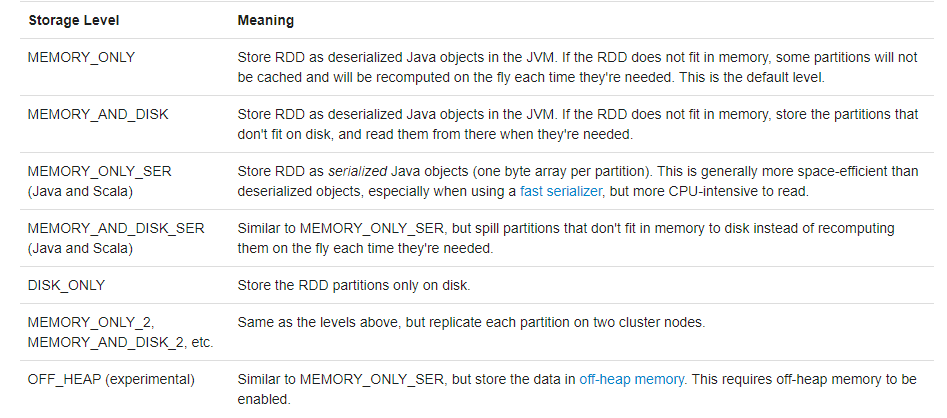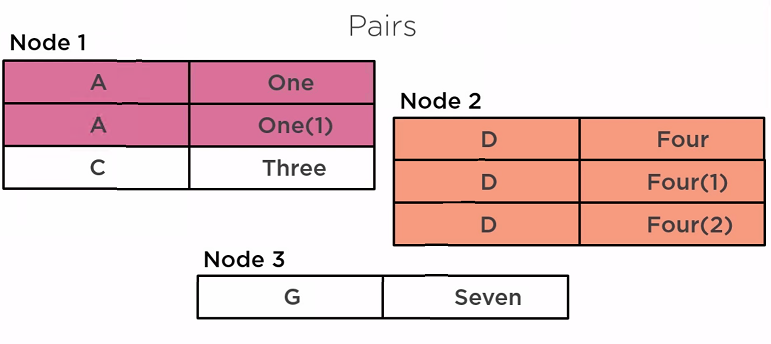- 深入解析:Shared Variables
- 深入解析:RDD Persistence
- 深入解析:RDD Key Value Pairs API
- 额外知识点:Implicit Conversion
Shared Variables
一般来说,Spark中的变量都是local变量,每个executor都有一份自己的copy,本地的变化不会反应到driver上。除此之外,Spark也提供了两种方法,实现全局变量。
Broadcast Variables
Broadcast variables are created from a variable v by calling SparkContext.broadcast(v).
scala> val broadcastVar = sc.broadcast(Array(1, 2, 3))
broadcastVar: org.apache.spark.broadcast.Broadcast[Array[Int]] = Broadcast(0)
scala> broadcastVar.value
res0: Array[Int] = Array(1, 2, 3)
创建了broadcast value之后,原始变量v就不要再用了,更不要再去修改它的值,以免发生错误。
Accumulators
A numeric accumulator can be created by calling SparkContext.longAccumulator() or SparkContext.doubleAccumulator() to accumulate values of type Long or Double, respectively.
scala> val accum = sc.longAccumulator("My Accumulator")
accum: org.apache.spark.util.LongAccumulator = LongAccumulator(id: 0, name: Some(My Accumulator), value: 0)
scala> sc.parallelize(Array(1, 2, 3, 4)).foreach(x => accum.add(x))
...
10/09/29 18:41:08 INFO SparkContext: Tasks finished in 0.317106 s
scala> accum.value
res2: Long = 10
Programmers can also create their own types by subclassing AccumulatorV2.
RDD Persistence
RDD主要是存储在
- 内存(Memory)
- 硬盘(Disk)
存在内存中,当然运算起来快,但是受到内存容量的限制。存在硬盘中,可以更加廉价地存储大量数据,但是读写上有速度限制。选择时需要综合考虑。
由此,引出 storage levels 如下图:

在上图中,除了上面提到的Memory,Disk,还有第三个变量Serialization,即序列化后的对象存储空间更小,但是需要额外计算(反序列化)消耗。
最终的存储级别,基本上就是这三个变量的一些组合。
在代码层面,可以使用两个方法实现persistence:
persist():可以选择StorageLevelcache():使用默认存储级别StorageLevel.MEMORY_ONLY
Which Storage Level to Choose?
- 根据数据量,从小到大,依次从上图选择。
- 如果需要fast fault recovery (e.g. if using Spark to serve requests from a web application),使用replicated storage levels,即
MEMORY_ONLY_2,MEMORY_AND_DISK_2, etc.
RDD Key Value Pairs API
Spark中Key Value Pair如果有多个值,在partition的时候,会尽量把同一个key的所有pairs分到一个node上。这样的好处是可以在单个node上完成所有关于这个key的操作。

下面列举一些常用API,都是在Class PairRDDFunctions<K,V>下的:
1
collectAsMap()
Return the key-value pairs in this RDD to the master as a Map.
mapValues(scala.Function1<V,U> f)
Pass each value in the key-value pair RDD through a map function without changing the keys;
flatMapValues(scala.Function1<V,scala.collection.TraversableOnce<U>> f)
Pass each value in the key-value pair RDD through a flatMap function without changing the keys;
reduceByKey(scala.Function2<V,V,V> func)
Merge the values for each key using an associative reduce function.
groupByKey()
Group the values for each key in the RDD into a single sequence.
countByKey()
Count the number of elements for each key, and return the result to the master as a Map.
2
join(RDD<scala.Tuple2<K,W>> other)
Return an RDD containing all pairs of elements with matching keys in this and other.
leftOuterJoin(RDD<scala.Tuple2<K,W>> other)
Perform a left outer join of this and other.
rightOuterJoin(RDD<scala.Tuple2<K,W>> other)
Perform a right outer join of this and other.
3
public void saveAsHadoopFile(String path,
Class<?> keyClass,
Class<?> valueClass,
Class<? extends org.apache.hadoop.mapred.OutputFormat<?,?>> outputFormatClass,
Class<? extends org.apache.hadoop.io.compress.CompressionCodec> codec)
Output the RDD to any Hadoop-supported file system, using a Hadoop OutputFormat class supporting the key and value types K and V in this RDD.
Implicit Conversion
隐式转换,即将typeS转换为typeT。
举例1,when calling a Java method that expects a java.lang.Integer, you are free to pass it a scala.Int instead by using 'Implicit Conversion'.
import scala.language.implicitConversions
implicit def int2Integer(x: Int) =
java.lang.Integer.valueOf(x)
举例2,通过隐式转换实现1.plus(1)。
// 1
case class IntExtensions(value: Int) {
def plus(operand: Int) = value + operand
}
// 2
import scala.language.implicitConversions
implicit def intToIntExtensions(value: Int) = {
IntExtensions(value)
}